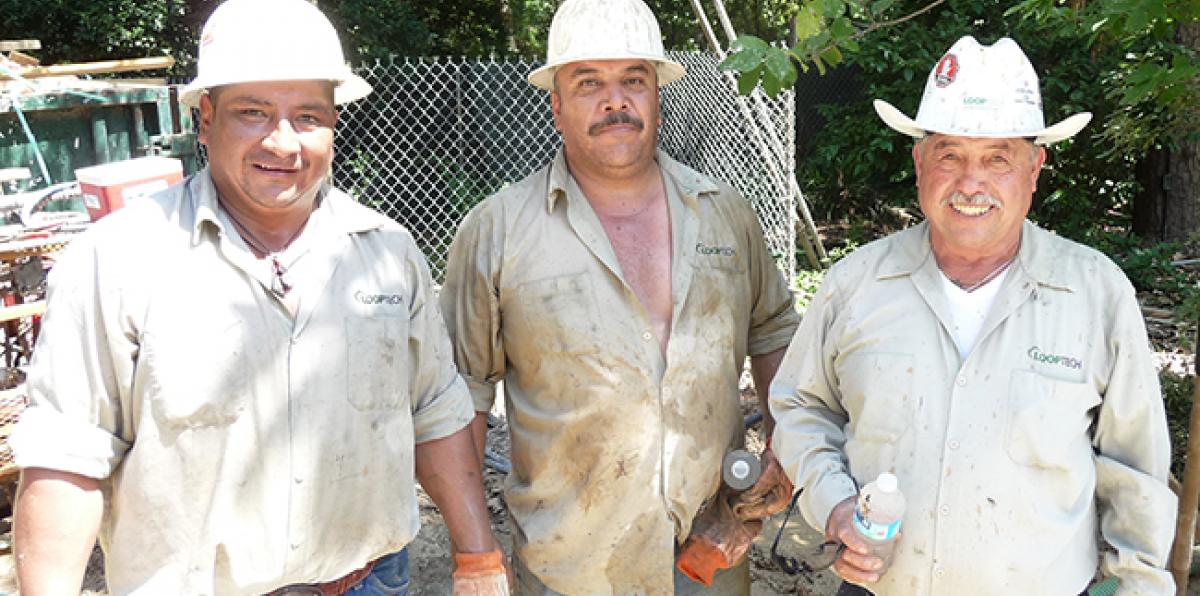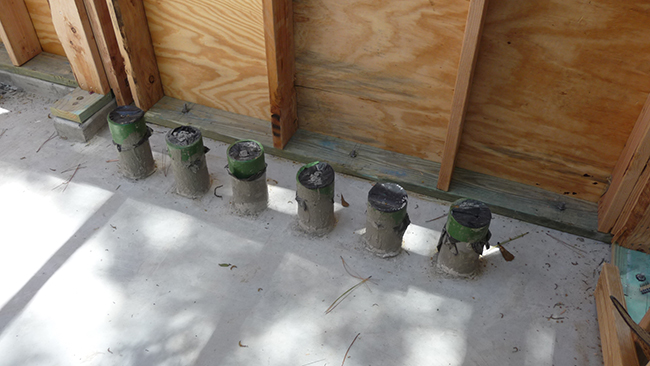THE DOGRUN
a place to share ideas


Craft Call: Jesse Quintana of LoopTech
Posted by vyuan on 6/24/15 at 9:14 am
On a recent site visit to the Bridge House in Houston, I caught our geothermal well drillers in action and asked them about the drilling process. As an alternative to conventional air conditioning systems, geothermal heating and cooling takes advantage of the stable temperature of the earth via a series of vertical wells or loops, providing heating, cooling, and hot water at very high efficiencies. Because the heat exchange is buried underground, a geothermal HVAC system eliminates outdoor equipment, avoiding unsightly condensers and their associated noise and long term maintenance. Although the initial cost of installation is higher than a conventional system, geothermal has been proven to provide a quick payback and very low operating costs. Currently, federal tax rebates offsetting 30% of the install cost expire at the end of 2016.
So, how many guys does it take to drill a vertical borehole? The answer is three: one guy to operate the rig, the other two to shovel out the clay, add on the drill pipe sections, and feed the polyethylene piping into the well (the coolest part).
Working for LoopTech, Jesse Quintana is our rig operator, and Onesimo Zavala and Faustino Macias get the daily workout on the job. Jesse has over 30 years of experience, and while he lives in nearby Huntsville, he travels all over the country for installations. He says that in 30 years, the drilling technology has not significantly changed, and he enjoys the summer travel to avoid the Texas heat.
On our job, we have 12 vertical boreholes planned under the future driveway, and they schedule to come out when the site is clear for their rig- it takes a full day’s work for a single borehole. Here are the steps:
 1. The boreholes on our project are 360’ deep, this depth will vary around the country based on the climate zone. The borehole itself is 5” wide, spaced at a minimum of 20 ft on center. Using a 35’ drill rig with 20’ drill pipe sections and a diamond bit, drilling takes about 5 hours on average. Timing depends on the soil conditions, Houston is clay so it’s relatively simple. This is what it looks like for 5 hours. Get excited.
1. The boreholes on our project are 360’ deep, this depth will vary around the country based on the climate zone. The borehole itself is 5” wide, spaced at a minimum of 20 ft on center. Using a 35’ drill rig with 20’ drill pipe sections and a diamond bit, drilling takes about 5 hours on average. Timing depends on the soil conditions, Houston is clay so it’s relatively simple. This is what it looks like for 5 hours. Get excited. 2. Each borehole requires about 500 gallons of water. Throughout the drilling process they retain the water and pump it to a 50 gallon holding tank that is recycled for the next borehole.
3. Bentonite (sold as Quik-Gel) is a clay mineral and viscosifier additive that aids in drilling – keeping the drill bit cool and keeping the walls from caving in.
4. When the depth is reached, a 1” high density polyethylene pipe is installed in the borehole. This piping coil has a continuous supply and return line with a bullet fitting at the interchange, which is taped onto a spear and shot down into the 360’ hole. You might ask how they get the spear out once the piping is set at the bottom – they literally step on the piping ends, and recoil the cable out, breaking the tape from the spear. This process takes only about 10 minutes:
5. After the piping is set, bentonite-based grout is injected via a ‘tremie' pipe to fill the void between the pipe and the walls of the borehole to permanently seal the hole, and the grout provides highly efficient thermo-conductivity between the loop and the earth.
After all 12 pipes are set, they are fused into a 4” main, with supply lines in and return lines out, and sleeved into the mechanical room manifold. Each well serves one ton of air conditioning.
2. Each borehole requires about 500 gallons of water. Throughout the drilling process they retain the water and pump it to a 50 gallon holding tank that is recycled for the next borehole.
3. Bentonite (sold as Quik-Gel) is a clay mineral and viscosifier additive that aids in drilling – keeping the drill bit cool and keeping the walls from caving in.
4. When the depth is reached, a 1” high density polyethylene pipe is installed in the borehole. This piping coil has a continuous supply and return line with a bullet fitting at the interchange, which is taped onto a spear and shot down into the 360’ hole. You might ask how they get the spear out once the piping is set at the bottom – they literally step on the piping ends, and recoil the cable out, breaking the tape from the spear. This process takes only about 10 minutes:
5. After the piping is set, bentonite-based grout is injected via a ‘tremie' pipe to fill the void between the pipe and the walls of the borehole to permanently seal the hole, and the grout provides highly efficient thermo-conductivity between the loop and the earth.
After all 12 pipes are set, they are fused into a 4” main, with supply lines in and return lines out, and sleeved into the mechanical room manifold. Each well serves one ton of air conditioning.  Finally the question you want to know – what’s Jesse’s favorite part of the job? It’s the drilling.
Finally the question you want to know – what’s Jesse’s favorite part of the job? It’s the drilling.
 1. The boreholes on our project are 360’ deep, this depth will vary around the country based on the climate zone. The borehole itself is 5” wide, spaced at a minimum of 20 ft on center. Using a 35’ drill rig with 20’ drill pipe sections and a diamond bit, drilling takes about 5 hours on average. Timing depends on the soil conditions, Houston is clay so it’s relatively simple. This is what it looks like for 5 hours. Get excited.
1. The boreholes on our project are 360’ deep, this depth will vary around the country based on the climate zone. The borehole itself is 5” wide, spaced at a minimum of 20 ft on center. Using a 35’ drill rig with 20’ drill pipe sections and a diamond bit, drilling takes about 5 hours on average. Timing depends on the soil conditions, Houston is clay so it’s relatively simple. This is what it looks like for 5 hours. Get excited. 2. Each borehole requires about 500 gallons of water. Throughout the drilling process they retain the water and pump it to a 50 gallon holding tank that is recycled for the next borehole.
3. Bentonite (sold as Quik-Gel) is a clay mineral and viscosifier additive that aids in drilling – keeping the drill bit cool and keeping the walls from caving in.
4. When the depth is reached, a 1” high density polyethylene pipe is installed in the borehole. This piping coil has a continuous supply and return line with a bullet fitting at the interchange, which is taped onto a spear and shot down into the 360’ hole. You might ask how they get the spear out once the piping is set at the bottom – they literally step on the piping ends, and recoil the cable out, breaking the tape from the spear. This process takes only about 10 minutes:
5. After the piping is set, bentonite-based grout is injected via a ‘tremie' pipe to fill the void between the pipe and the walls of the borehole to permanently seal the hole, and the grout provides highly efficient thermo-conductivity between the loop and the earth.
After all 12 pipes are set, they are fused into a 4” main, with supply lines in and return lines out, and sleeved into the mechanical room manifold. Each well serves one ton of air conditioning.
2. Each borehole requires about 500 gallons of water. Throughout the drilling process they retain the water and pump it to a 50 gallon holding tank that is recycled for the next borehole.
3. Bentonite (sold as Quik-Gel) is a clay mineral and viscosifier additive that aids in drilling – keeping the drill bit cool and keeping the walls from caving in.
4. When the depth is reached, a 1” high density polyethylene pipe is installed in the borehole. This piping coil has a continuous supply and return line with a bullet fitting at the interchange, which is taped onto a spear and shot down into the 360’ hole. You might ask how they get the spear out once the piping is set at the bottom – they literally step on the piping ends, and recoil the cable out, breaking the tape from the spear. This process takes only about 10 minutes:
5. After the piping is set, bentonite-based grout is injected via a ‘tremie' pipe to fill the void between the pipe and the walls of the borehole to permanently seal the hole, and the grout provides highly efficient thermo-conductivity between the loop and the earth.
After all 12 pipes are set, they are fused into a 4” main, with supply lines in and return lines out, and sleeved into the mechanical room manifold. Each well serves one ton of air conditioning.  Finally the question you want to know – what’s Jesse’s favorite part of the job? It’s the drilling.
Finally the question you want to know – what’s Jesse’s favorite part of the job? It’s the drilling.